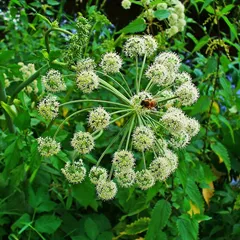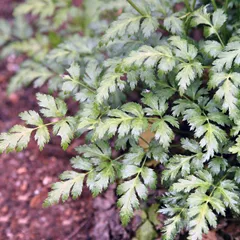Xia Ru Yong Quan San
Chinese: 下乳涌泉散
Pinyin: Xià Rú Yǒng Quán Sàn
Other names: Promoting Lactation Gushing Spring Powder








Xia Ru Yong Quan San
Chinese: 下乳涌泉散
Pinyin: Xià Rú Yǒng Quán Sàn
Other names: Promoting Lactation Gushing Spring Powder
Ingredients: 11 herbs
Category: Formulas that invigorate Blood and dispel Blood Stagnation
- Nourishes Blood
- Increases breast milk supply
Source: 清太医院配方 / Collection of Qing Royal Palace Doctors' fomula (1840 AD )
The information provided here is not a replacement for a doctor. You shouldn't use it for the purpose of self-diagnosing or self-medicating but rather so you can have a more informed discussion with a professional TCM practitioner.
Xia Ru Yong Quan San is a 11-ingredient Chinese Medicine formula with Dong Quai (Dang Gui) as a principal ingredient.
Invented in 1840 AD, it belongs to the category of formulas that invigorate Blood and dispel Blood Stagnation. Its main actions are: 1) nourishes Blood and 2) increases breast milk supply.
In Chinese Medicine health conditions are thought to arise due to "disharmonies" in the body as a system. These disharmonies are called "patterns" and the very purpose of herbal formulas is to fight them in order to restore the body's harmony.
In this case Xia Ru Yong Quan San is used by TCM practitioners to fight patterns like Liver Qi Stagnation. From a Western Medicine standpoint, such patterns can give rise to a range of conditions such as low breast milk supply for instance.
On this page, after a detailed description of each of the eleven ingredients in Xia Ru Yong Quan San, we review the patterns and conditions that Xia Ru Yong Quan San helps treat.
The eleven ingredients in Xia Ru Yong Quan San

Dang Gui is a king ingredient in Xia Ru Yong Quan San. Like the name indicates, it means it has more power than other ingredients in the formula.
1. Dong Quai (Dang Gui)
Part used: Dried root
Nature: Warm
Meridian affinity: HeartLiverSpleen
Category: Tonic herbs for Blood Deficiency
In general Dang Gui's main actions are as follows: "Tonifies the Blood. Lubricates the Intestines. Relieve constipation. Promotes circulation and dispels Bi Pain. Reduce Dysmenorrhea and help with irregular menstruation."
In the context of Xia Ru Yong Quan San, it is used because it nourishes and invigorates Blood.

Jie Geng is an envoy ingredient in Xia Ru Yong Quan San. This means that it directs the formula towards certain area of the body and/or harmonizes the actions of other ingredients.
2. Platycodon Roots (Jie Geng)
In general Jie Geng's main actions are as follows: "Opens the Lungs and smoothes the flow of Lung Qi. Expels Phlegm and pus from the Lungs and throat, can be used for either Wind-Cold or Wind-Heat according to the other herbs in the formula. Directs the actions of other herbs to the Upper Burner. "
In the context of Xia Ru Yong Quan San, it is used because it plays the carrier role to direct the ingredients to the Upper Burner.

3. White Peony Roots (Bai Shao)
Part used: Dried root
Nature: Neutral
Meridian affinity: LiverSpleen
Category: Tonic herbs for Blood Deficiency
In general Bai Shao's main actions are as follows: "Tonifies the Blood and preserves the Yin. Nourishes the Liver and assists in the smooth flow of Qi. Regulates the meridians and eases the pain."
In the context of Xia Ru Yong Quan San, it is used because it nourishes and invigorates Blood.

4. Szechuan Lovage Roots (Chuan Xiong)
Part used: Dried rhizome
Nature: Warm
Taste(s): Pungent
Meridian affinity: GallbladderLiverPericardium
Category: Herbs that invigorate the Blood
In general Chuan Xiong's main actions are as follows: "Regulates and moves the Blood. Relieves Wind-Cold and pain. Circulates the Qi in the Upper Burner, relieving headaches."
In the context of Xia Ru Yong Quan San, it is used because it nourishes and invigorates Blood.

5. Unprepared Rehmannia (Di Huang)
Part used: Prepared dried root tuber
Nature: Cold
Taste(s): Sweet
Meridian affinity: HeartKidneyLiver
Category: Herbs that cool the Blood
In general Di Huang's main actions are as follows: "Expels Heat by Cooling Blood. Tonifies Yin by promoting Fluid production. Soothes the Heart by calming Blazing Fire. Cools and nourishes."
In the context of Xia Ru Yong Quan San, it is used because it nourishes Body Fluids.

6. Bupleurum Roots (Chai Hu)
In general Chai Hu's main actions are as follows: "Harmonizes exterior and interior. Smoothes the Liver and upraises the Yang."
In the context of Xia Ru Yong Quan San, it is used because it moves Qi and eliminates Stagnation.

7. Maral Roots (Lou Lu)
In general Lou Lu's main actions are as follows: "Expels Heat and reduces toxic swellings. Increases the flow of mothers' milk."
In the context of Xia Ru Yong Quan San, it is used because it resolves Toxic Heat and promotes lactation.

8. Vaccaria Seeds (Wang Bu Liu Xing)
Part used: Dried seeds
Nature: Neutral
Taste(s): Bitter
Meridian affinity: StomachLiver
Category: Herbs that invigorate the Blood
In general Wang Bu Liu Xing's main actions are as follows: "Invigorates Blood. Promotes lactation and menstruation. Reduces painful swelling of the breasts and testicles."
In the context of Xia Ru Yong Quan San, it is used because it invigorates Blood and promotes lactation.

9. Snake Gourd Roots (Tian Hua Fen)
In general Tian Hua Fen's main actions are as follows: "Clears Heat in the Lungs and moistens Dryness, especially when there is Phlegm that is aggravating the condition. Brings down inflammation and reduces pus."
In the context of Xia Ru Yong Quan San, it is used because it nourishes Body Fluids.

10. Green Tangerine Peel (Qing Pi)
Part used: Dried pericarp of the young or immature fruits
Nature: Warm
Meridian affinity: GallbladderStomachLiver
Category: Herbs that regulate Qi
In general Qing Pi's main actions are as follows: "Smooths the flow of Liver Qi and releases Stagnation. Reduces Food Stagnation. Dries Damp and reduces Phlegm."
In the context of Xia Ru Yong Quan San, it is used because it moves Qi and eliminates Qi Stagnation.

11. Tetrapanax Piths (Tong Cao)
Part used: Dried stem pith
Nature: Cool
Taste(s): Sweet
Meridian affinity: StomachLung
Category: Herbs that drain Dampness
In general Tong Cao's main actions are as follows: "Removes heat, induces urination and stimulates lactation"
In the context of Xia Ru Yong Quan San, it is used because it removes Stagnation from the breast connecting Meridians.
Xia Ru Yong Quan San is used to treat Liver Qi Stagnation
It's important to remember that herbal formulas are meant to treat patterns, not "diseases" as understood in Western Medicine. According to Chinese Medicine patterns, which are disruptions to the body as a system, are the underlying root cause for diseases and conditions.
As such Xia Ru Yong Quan San is mostly used to treat the pattern "Liver Qi Stagnation" which we describe below.
But before we delve into Liver Qi Stagnation it is worth mentioning that it is often associated with the condition "low breast milk supply". Again it wouldn't be correct to say "Xia Ru Yong Quan San treats low breast milk supply". Rather, Xia Ru Yong Quan San is used to treat Liver Qi Stagnation, which is sometimes the root cause behind low breast milk supply.
Now let's look at Liver Qi Stagnation, a pattern that TCM practitioners commonly treat with Xia Ru Yong Quan San.

The Liver is a so-called "Zang" Organ. Learn more about the Liver in Chinese Medicine
Liver Qi Stagnation
Pulse type(s): Wiry (Xian)
Tongue color: Normal (light red)
Symptoms: Anger Fever Nausea Sighing Anxiety Melasma Blister Vomiting Diarrhea Belching Moodiness Hiccuping Headaches Dark face Melancholy Depression Borborygmi Neck lumps Flank pain Mood swings Fluctuation Breast pain Irritability Breast lumps Constipation Poor appetite Breast eczema Abdominal pain Epigastic pain Breast redness Breast nodules Scanty periods Clots in blood Breast hardness Chest distension Menstrual cramps Frequent sighing Breast distention Dark nipple color Thick breast milk Abdomen distension Hypochondriac pain Clogged milk ducts Breast skin cracks Uneven milk supply Dark colored blood Suppressed emotions Premenstrual tension Breast pus discharge Breast skin ichiness Abdominal distension Lower abdominal pain Feeling of distension Epigastric distension Pre-menstrual tension Epigastrium distension Irregular menstruation White spots on nipples Feelings of frustration HypochondriaI distension Yellow vaginal discharge Sticky vaginal discharge Alternating fever and chills Feeling of lump in the throat Premenstrual breast distension Churning feeling in the stomach Abdominal distention and fullness Feeling of pulsation in epigastrium Alternating constipation and diarrhea Insufficient or absent lactation after childbirth Stifling sensation in the chest causing one to have deep sighs
Xia Ru Yong Quan San is sometimes prescribed by TCM practitioners to treat Liver Qi Stagnation. This pattern leads to symptoms such as hypochondriai distension, chest distension, epigastrium distension and abdomen distension. Patients with Liver Qi Stagnation typically exhibit wiry (Xian) pulses as well as Normal or slightly red on the sides.
When Liver Qi does not flow smoothly or regularly, it becomes Stagnant and in Excess. This leads to Heat accumulating in the Liver. This affects not only the Liver, but other connected Organs as well as the Seven Emotions.
Liver Qi Stagnation is not only the most seen Liver disharmony, but also one... read more about Liver Qi Stagnation
Formulas similar to Xia Ru Yong Quan San
Xue Fu Zhu Yu Tang is 45% similar to Xia Ru Yong Quan San
Jing Jie Lian Qiao Tang is 38% similar to Xia Ru Yong Quan San
Bai He Gu Jin Tang is 36% similar to Xia Ru Yong Quan San
Tuo Li Xiao Du San is 36% similar to Xia Ru Yong Quan San
Qing Re Tiao Xue Tang is 36% similar to Xia Ru Yong Quan San
Di Gu Pi Yin is 36% similar to Xia Ru Yong Quan San














